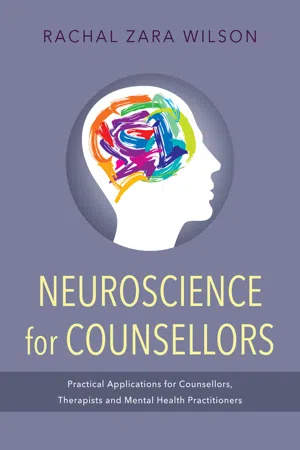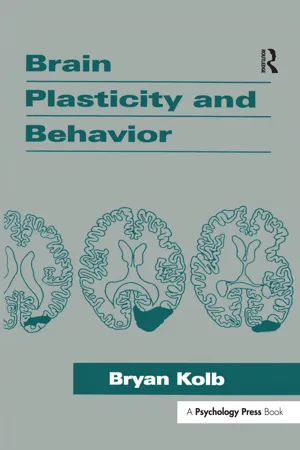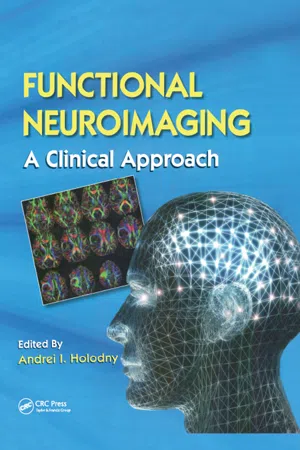Psychology
Neural Plasticity
Neural plasticity refers to the brain's ability to reorganize itself by forming new neural connections throughout life. It allows the brain to adapt to experiences, learn new information, and recover from injuries. This process is essential for learning and memory, and it underlies the brain's ability to recover from damage and adapt to changes in the environment.
Written by Perlego with AI-assistance
Related key terms
8 Key excerpts on "Neural Plasticity"
- eBook - ePub
Neuroscience for Counsellors
Practical Applications for Counsellors, Therapists and Mental Health Practitioners
- Rachal Zara Wilson(Author)
- 2014(Publication Date)
- Jessica Kingsley Publishers(Publisher)
Chapter 2 Plasticity and How the Brain Works Plasticity is one of the newer discoveries of neuroscience, and it changes our concept of the brain and how it works. It also changes our ideas about what is possible when the brain is working in a dysfunctional way. Plasticity and BDNF What do we know? First, some very basic neuroscience, for which much more detailed and complicated explanation is available from other sources (Haines, 2006; Kandel, Schwartz and Jessell, 1995; Squire, 2008). Neurons are one of the two main classes of cells in the brain, the other class being glial cells. Neurons are the signalling units of the nervous system. There are different types for example, sensory neurons, motor neurons, and interneurons that perform a relay function. Neurons have tails, called axons, with dendrites extending from the axon like branches of a tree. Axons vary in length from very tiny to almost a metre long. They are typically sheathed in a substance called myelin, provided by the glia. Every neuron has thousands of connections with other neurons across small spaces called synapses. Communication across the synapses can be either chemical, through the secretion and reception of a variety of neurotransmitters, or electrical, via electrical charge from the head of the pre-synaptic neuron to the dendrites of the post-synaptic neuron that polarizes or depolarizes the next neuronal cell. (These are called action potentials.) Plasticity comes from the Greek word plaistikos (Johnston, 2003). In the term ‘brain plasticity’ it refers to the recently discovered ability of the brain to change itself and to adapt to its environment by weakening or strengthening different synaptic connections (Ben-Shachar and Laifenfeld, 2004). Hebb (1949) was the first to conceive of networks of ‘cellular assemblies’, or neuronal connections, which, when used repeatedly, formed preferential pathways in the brain - eBook - ePub
Distributed Perception
Resonances and Axiologies
- Natasha Lushetich, Iain Campbell, Natasha Lushetich, Iain Campbell(Authors)
- 2021(Publication Date)
- Routledge(Publisher)
Part IIPlasticity
DOI: 10.4324/9781003157021-9Passage contains an image
7 Unstable brains and ordered societies
David W. BatesOn the conceptual origins of plasticity, ca . 1900DOI: 10.4324/9781003157021-10Within contemporary neuroscience, plasticity has emerged as a foundational and dominant concept, one confirmed by advanced imaging techniques as well as extensive clinical, experimental, and theoretical work. While the concept seems to imply radical openness and even freedom, in fact the neuroscientific idea of plasticity has been seamlessly assimilated into computational models of the mind. Several research groups have embarked on projects to construct neuro-synaptic chips that mimic the kind of connectivity and learning potential of organismic brains (see Akopyan et al . 2015 ), and one could also argue that the massive influence of deep learning and other forms of artificial intelligence that rely on artificial neural networks has provoked new models of cognition predicated on the dynamic plasticity of connective ‘weights’ and their constant adjustment and transformation. This blurring and interplay between neural and technical discourses is hardly unprecedented. Yet today, given the increasing intensity and accelerated speed of our digital infrastructure, the actual relationship between our living brains and our technical sphere demands more critical attention. If modern algorithmic systems are not simply predicting human behaviours but also moulding them via our plastic minds and brains, what kind of human beings are we becoming?Despite some tentative, and often unsatisfying, efforts to probe the links between brain plasticity, technology, and the formation of culture in evolutionary psychology and cognitive science (e.g. McDermott 2016 - eBook - ePub
- Bryan Kolb(Author)
- 2013(Publication Date)
- Psychology Press(Publisher)
One of the implications of the plastic changes that underlie both recovery from the processes of aging and brain injury is that the brain may be more successful in recovering in younger animals than in older ones because there are more remaining neurons to change. This is unfortunately the case. Another implication is that people who have brain damage early in life may not be as successful in staving off the effects of age on the brain. When the brain changes to allow recovery from injury, it may exploit mechanisms to be used later for compensating for aging. When this change is needed, the brain is not able to respond.Conclusions and Directions
One of the fundamental, and most interesting, properties of the brain is its plasticity. This feature of the brain allows us to learn and to benefit from experience. It also allows us to live a relatively long life during which we are able to continue to learn new things. Work on neuronal plasticity is elaborating the ways that the brain is plastic and discovering ways to control the mechanisms that underlie plasticity. This offers considerable hope that sometime in the not too distant future we will be able to build better brains and to repair broken ones.The goals of the rest of this book are to: (a) identify the constraints on behavioral change, (b) describe the neuronal correlates of the behavioral changes, and (c) identify those factors that control or influence the brain and behavioral changes. The analysis of brain and behavioral change is necessarily correlational, which makes it difficult to make conclusions about causation. In addition, my focus must also be on experiments that have done both behavioral and anatomical investigations. The critical experiments must therefore be those in which one attempts to challenge the correlations between brain and behavioral changes. As we shall see, these are also some of the most difficult experiments to conduct.Passage contains an image
2 Plasticity in the Normal Brain
DOI: 10.4324/9780203773765-2Brain plasticity results from changes in the synapse. The formation of new synapses has a cost, however, as there are also increases in dendrites, axon terminals, glia, and blood capillaries. The mechanisms controlling plasticity therefore include more than just those things that directly change synapses or create new ones, but also include those mechanisms that change the supporting cast of the synapse. One thing that follows from the multiple changes in the brain accompanying plasticity is that plasticity can be inferred from the study of many things, including the direct measurement of synapses as well as the measurement of axon terminals, dendritic arborizations and spines, glia, and capillaries. - eBook - ePub
Functional Neuroimaging
A Clinical Approach
- Andrei I. Holodny(Author)
- 2019(Publication Date)
- CRC Press(Publisher)
7 Cortical Plasticity ANDREI I. HOLODNYThe Neuroradiology Section and the Functional MRI Laboratory, Department of Radiology, Memorial Sloan-Kettering Cancer Center, New York, New York, U.S.A.INTRODUCTIONBrain plasticity or cortical reorganization can be defined as follows: when a pathological process affects the function of one part of the brain, another part of the brain attempts to take over that function and succeeds at least partially. Until rather recently, it was thought that cortical reorganization essentially never occurred in the adult brain. It was believed that once the adult brain was formed, the number of neurons could only diminish and that once a part of the brain became damaged, the function supplanted by that part could never be restored.However, recent work, for example in the field of stem cells in the central nervous system, has altered this opinion. Functional brain imaging has also been instrumental in demonstrating that cortical reorganization actually does occur. Imaging is essential in revealing brain plasticity because of its ability to show changes in brain function over time. A number of different techniques have shown brain plasticity in both animals and humans. These include experimental techniques, such as stem cell tracking, most of which lie outside everyday clinical practice and are therefore outside the purview of this book. We will concentrate on a technique which is readily available—namely blood oxygen level-dependent (BOLD) functional magnetic resonance imaging (fMRI).UNEXPECTED RESULTSAs we have already seen in other chapters, BOLD fMRI is becoming an indispensable technique in preoperative (as well as intraoperative) mapping of eloquent cortices adjacent to a tumor to be resected. If preoperative BOLD fMRI is available, neurosurgeons quickly become most appreciative of this technique and averse to operate without it (1 - eBook - ePub
Endangered Minds
Why Children Dont Think And What We Can Do About I
- Jane M. Healy(Author)
- 2011(Publication Date)
- Simon & Schuster(Publisher)
Scientists hesitate to make definitive statements on this point because they have not had the technology available to get the evidence for large groups of “normal” children. Even with new computerized techniques of brain imaging, it is still difficult to pin down subtle changes at the level of the neuron. Moreover, most research dollars have gone to the pressing issue of serious disability, so most available evidence comes from youngsters whose brains have been injured through illness or accident. They provide dramatic evidence for plasticity. Frequently children master skills even when the neurons thought to be important are missing or damaged. For example, very young children with severe injury in the brain’s language areas can develop remarkably good abilities to talk, understand language, read, and write. These brains have been able to develop new structural connections to bypass injured areas and also to reorganize functionally by using alternate, undamaged areas. With a cast of understudies, the final performance is usually somewhat impaired, but young brains are astonishingly flexible.What about older ones? While new tricks are indeed harder for old synapses, studies of stroke victims prove that with sufficient effort the human brain may be remolded to some extent at any age. The latest research confirms this principle for healthy brains as well. In fact, as I write this book and you read it, our brains are not even the same from moment to moment. The very acts of writing and reading are doubtless changing, very subtly, the way some cells connect together. I find this idea thought-provoking, and I can even become somewhat confounded thinking that while I am thinking this thought-provoking thought, my brain is probably being changed by it!It is much more difficult, however, to reorganize a brain than it is to organize it in the first place. “Organization inhibits reorganization,” say the scientists.7 Carving out neuronal tracks for certain types of learning is best accomplished when the synapses for that particular skill are most malleable, before they “firm up” around certain types of responses.Hard Wiring and Open Circuits
Animal brains have an easy time of it. They carry out many of the basic routines of keeping alive, fed, and safe, reproducing and caring for the young, with preprogrammed neural systems that do the work without asking questions. While these more primitive brains are clearly capable of learning, more of their cells are committed to hardwired - eBook - ePub
Somatosensory Processing
From Single Neuron to Brain Imaging
- Mark Rowe, Yoshiaki Iwamura(Authors)
- 2001(Publication Date)
- CRC Press(Publisher)
CHAPTER 11CORTICAL PLASTICITY: GROWTH OF NEWCONNECTIONS CAN CONTRIBUTE TOREORGANIZATION
Sherre L. Florence and Jon H. KaasDepartment of Psychology, Vanderbilt University, Nashville, TN, USA“It appears that most of the earlier reports of the high functional plasticity of the nervous system will go down in the record as unfortunate examples of how an erroneous medical scientific opinion, once implanted, snowball(s) until it biases experimental observations and crushes dissenting interpretations.” (Sperry, 1959).As evidenced in the quote above by Sperry there was a longstanding belief that the organization of the adult brain is relatively fixed. However, it is clear that the processing machinery of the brain must have the ability to change, even in the mature brain, to reflect behavioral recoveries after damage, the learning of new skills, and perceptual reorganizations after sensory distortions. Indeed, we now know that the adult brain is highly adaptable.Some of the most persuasive early evidence of the potential for the adult brain to change came from studies of the effects of injury on the organization of sensory representations in the primary somatosensory pathway. In somatosensory cortex, where there are large twodimensional representations of the receptor surfaces, even small changes in neuronal response properties can be detected. This made it easy to demonstrate that populations of neurons, when deprived of their normal sources of activation, become immediately responsive to remaining sources of sensory input (Fig. 11.1 ). The earliest evidence of this immediate cortical reorganization was shown by Merzenich and colleagues (Merzenich et al ., 1983a, 1983b); since then, similar changes have been documented under a number of circumstances and in a variety of species (for review see Kaas, 1991). Similar rapidly occurring changes have been reported, on a smaller scale, in other parts of the somatosensory pathway, including the spinal cord (e.g. Basbaum and Wall, 1976; Wall, 1977; Mendell et al ., 1978; Devor and Wall, 1981; Pubols and Brenowitz, 1981; Wilson and Snow, 1987), the dorsal column nuclei (e.g. Wall and Egger, 1971; Dostrovsky et al ., 1976; Millar et al ., 1976; McMahon and Wall, 1983; Pettit and Schwark, 1993; Northgrave and Rasmusson, 1996) and thalamus (e.g. Wall and Egger, 1971; Pollin and Albe-Fessard, 1979; Garraghty and Kaas, 1991; Nicolelis, 1993; Rasmusson, 1993, 1996a, 1996b; Shin et al ., 1995) . The magnitudes of these rapidly occurring changes were small (on the order of half a millimeter or less), and were attributed to the rapid unmasking, or the potentiation, of previously existing connections (for review see Wall, 1977; Devor, 1983). The unmasking is thought to result from the down-regulation of activity-driven inhibition on previously sub-threshold inputs (Fig. 11.1 - eBook - ePub
Advances in Psychological Science, Volume 2
Biological and Cognitive Aspects
- Fergus Craik, Michele Robert, Michel Sabourin(Authors)
- 2014(Publication Date)
- Psychology Press(Publisher)
Indeed, it has become clear in recent years that the structural changes underlying experientially induced plasticity, such as in perceptual development, are remarkably similar to those underlying recovery from some types of brain injury. There is a corollary to this assumption: Similar mechanisms of plasticity are likely to be used across a broad range of species. I must admit parenthetically at this point that I am an unabashed vertebrate chauvinist, so my emphasis will be on vertebrates and especially on mammals. I do not exclude the possibility that animals such as Aplysia may use mechanisms similar to those in mammals, but my suspicion is that we will learn more about forebrain function in humans by studying animals whose brains, and thus perceptual processes, are more similar to ours than is the case for most invertebrates. Third, I assume both that the mechanisms of cortical plasticity are most likely to be found at the synapse and that synaptic changes can be measured by analysis of either pre- or postsynaptic structure. Traditionally, the emphasis in the literature on synaptic plasticity has been upon the presynaptic, or axonal terminal, side. Although this may be a practical site to study if one is interested in reparative processes after injury to peripheral nerves (e.g. Diamond, 1988), it is not so practical for studies of cortical structure. In particular, one difficulty with studying presynaptic changes is that they are very difficult to locate unless one knows a priori where to look. In addition, once found, they are difficult to quantify. The ability to quantify specific morphological features is critical if one is to correlate structural change with behavior. An alternate way to look at synaptic change is to study the postsynaptic, or dendritic, side. This requires that the complete cell body and dendritic tree be stained, such as in a Golgi-type stain - eBook - ePub
Cell Biology Assays
Essential Methods
- Fanny Jaulin, Cedric Espenel(Authors)
- 2009(Publication Date)
- Academic Press(Publisher)
VII. NEURONAL PLASTICITY - MEMORYPassage contains an image
Stress and Neuronal Plasticity
B S McEwen The Rockefeller University, New York, NY, USA© 2009 Elsevier Ltd. All rights reserved.Introduction
The brain is the key organ of the stress response insofar as it processes information and determines whether an event or situation is threatening. Moreover, the outputs of the brain include regulation of autonomic, neuroendocrine and immune function, and behavioral responses that can be health promoting or health damaging. The brain is an adaptable organ, and both acute and chronic stress produce structural as well as neurochemical alterations that are, for the most part, reversible. Yet, severe insults such as seizures, strokes, and head trauma cause permanent damage, and there is also reason to believe that severe and prolonged stress, as well as disorders such as major depression, may also lead to permanent neural damage if they go on for a very long time.Animal models have provided clues as to how the brain adapts to acute and repeated stress, and the hippocampus is the best-studied brain region. The hippocampus, which is an important brain structure for spatial, contextual, and declarative memory contains receptors for adrenal steroids, which regulate excitability and the morphological changes together with glutamate as well as other neurotransmitters and a host of endogenous neurochemicals.This article first discusses the hippocampus and then turns to two other stress-sensitive brain structures, namely, the amygdala and prefrontal cortex. It then considers the behavioral consequences of remodeling of neural connections by stress and whether the remodeling increases or decreases the vulnerability of the brain to permanent damage. Finally, the relevance of the structural changes to the mood and anxiety disorders is discussed.Adaptive Structural Plasticity
One of the ways that stress hormones modulate function within the brain is by changing the structure of neurons. Within the hippocampus, the input from the entorhinal cortex to the dentate gyrus is ramified by the connections between the dentate gyrus and the CA3 pyramidal neurons. One granule neuron innervates, on average, 12 CA3 neurons, and each CA3 neuron innervates, on average, 50 other CA3 neurons via axon collaterals, as well as 25 inhibitory cells via other axon collaterals. The net result is a 600-fold amplification of excitation, as well as a 300-fold amplification of inhibition, that provides some degree of control of the system.
Learn about this page
Index pages curate the most relevant extracts from our library of academic textbooks. They’ve been created using an in-house natural language model (NLM), each adding context and meaning to key research topics.







